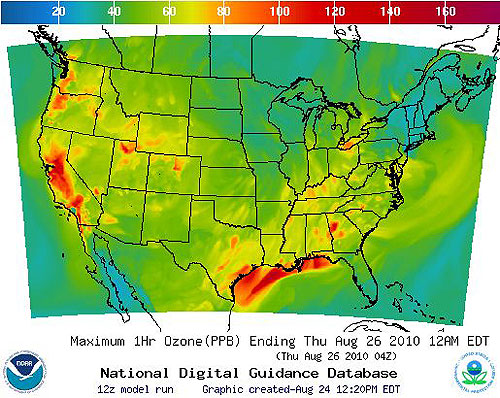Science Wednesday: Breathing New Life into Air Quality Forecasting in Towns Big and Small
 Each week we write about the science behind environmental protection. Previous Science Wednesdays.
Each week we write about the science behind environmental protection. Previous Science Wednesdays.
I’m from a small town in Colorado. Not much industry, not many people. It was great growing up with clean air, clear streams, corn fields, cows, and wide open skies.
Now I work at one of EPA’s greatest facilities with scientists who specialize in understanding air pollution exposure. Because of this, more than ever, I pay attention to air quality.
EPA’s commitment to clean air has resulted in many excellent modeling and analysis tools that can warn people about unhealthy air quality — including “Ozone Action Day” alerts. Some people get these warnings from newspapers or their local weather forecaster, or from AirNow — a web-based clearinghouse that offers daily air quality index forecasts for approximately 300 of the largest U.S. metropolitan areas. The AirNow database was developed in 1998 by EPA, NOAA, Environment Canada, and the U.S. National Park Service along with state, local and tribal air agencies.
Growing up, the same person who presented the local weather forecast on the evening news also served as the agricultural reporter. She did her best with the available information, but was clearly more skilled in reporting on cows and corn than the weather.
But I’ve wondered — do small-town citizens routinely get accurate information about air quality from their local weather forecasters? Not sure.
But they could.
It’s available through the National Air Quality Forecast Guidance, a tool developed by EPA and NOAA scientists that generates air quality forecasts — for the entire country.
 EPA researcher Brian Eder, and colleagues recently evaluated the guidance to see if it was — or wasn’t — providing local ozone forecasts every bit as accurate as those provided by AirNow. The results: the guidance delivers!
EPA researcher Brian Eder, and colleagues recently evaluated the guidance to see if it was — or wasn’t — providing local ozone forecasts every bit as accurate as those provided by AirNow. The results: the guidance delivers!
Eder’s paper, “Using National Air Quality Forecast Guidance to develop local air quality index forecasts,” in the Bulletin of the American Meteorological Society, explains how people who aren’t trained air quality forecasters can use the guidance to generate localized information that can help people make smarter health decisions regarding outdoor activities on high ozone days.
The economy is such that hiring a trained air quality forecaster probably isn’t on my town’s list of priorities. Nonetheless, I hope towns big and small will discover, and use the guidance to better serve their citizens and protect public health.
About the author: Robin Baily is a writer/editor at EPA’s National Exposure Research Laboratory in Research Triangle Park, N.C.
Editor’s Note: The opinions expressed in Greenversations are those of the author. They do not reflect EPA policy, endorsement, or action, and EPA does not verify the accuracy or science of the contents of the blog.

Sep 08, 2010 @ 11:17:41
What small town in Colorado? My folks grew up in Hugo and i spent many a summer weekend there with my grandparents.
Sep 09, 2010 @ 07:50:27
Hi Linda j,
My town is LaJunta — close to the Kansas border and to Fort Bent. How’d you like Hugo?? I’m thinking that LJ and Hugo may have competed in football in jr high. When did you visit Hugo?
Sep 09, 2010 @ 07:36:46
Hey Linda j! Hugo — wow, I think my jr high school football team played your team. We probably lost…..
I’m from LaJunta — closer to Kansas than to the mountains. LJ was about 11,000 when I was young.
Tell me about Hugo.
Sep 12, 2010 @ 08:25:33
Sorry i couldn’t help but jump in to the conversations but i’m from Gunnison and I loved your article. I live in Orange County now but you’d think that i could at least get a good ozone forcast on my yahoo home page. do you think that the epa could eventually have the ozone levels right next to the weather on our internet homepages… it might be the easiest way to get the information out. just a thought.
Sep 15, 2010 @ 07:28:29
Jerry — Ain’t CO the best??!!
Where is your Orange County??
About getting ozone forecasts placed on a specific site in a specific place may be bitg of a challenge. Lemme check around and I’ll get back to you.
Later,
Robin
Sep 22, 2010 @ 07:31:32
Hi, Thanks such a great information’s really like to read this topic. This is really a well written article about a great project! It’s very useful.
Sep 22, 2010 @ 09:19:27
Hey Rabbi — really glad you found the info useful, and thanks for the kind words. I really think that the more people know the better their decisions are.
Some other scientists that I work with are are analyzing exhaled breath — not to check for alcohol — to see if we can tell what chemicals the person has been exposed to. The bugs are still being worked out but there’s a whole group of scientists, internationally, working on that. Maybe one day, a routine test at the dr’s office will be to exhale into a tube and get a reading of our exposures… Very cool.
Stay safe, Rabbi.
Best,
Robin
Oct 01, 2011 @ 14:00:49
I am envious that the US has dedicated people to monitor the air, ozone levels etc so that they can provide bettwer quality of life for its citizen. Where I come from ( SE Asia ), its a norm that every year our neighboring country will pollute the air with it’s open jungle burning to clear them for the next crop season plantin and there’s nothing we can do about it… sigh…
Mary